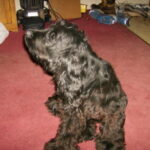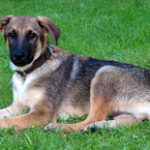Ectropion is a condition in dogs in which the lower eyelid rolls outward, giving the eye a loose or droopy appearance. The position of the eyelid exposes the internal lining, known as the palpebral conjunctiva. Ectropion may be seen in one or both eyes.
Causes of Ectropion
Ectropion can occur in any breed, but it is considered an inherited characteristic in breeds such as the Basset Hound, Bloodhound, Cocker Spaniel, Clumber Spaniel, English Bulldog, Mastiff, Newfoundland, and St. Bernard. In other breeds, it is often seen in young dogs who have not yet matured into their facial structure and older dogs who are losing muscle tone.
Other causes of ectropion include marked weight loss, loss of muscle mass, injury to the eye or eyelid, chronic inflammation in the eye, surgical overcorrection of entropion (inward turning of the eyelid), and hypothyroidism. Temporary ectropion may be seen when the dog is fatigued after a hard day at play.
Symptoms of ectropion
Dogs with ectropion will have lower eyelids that roll forward, exposing the eye. The conjunctiva may appear red or inflamed due to dryness from exposure or irritation from foreign objects. The pouch that is formed by the eyelid can accumulate grass, dust, pollen or other items that may rub against the eye and the conjunctiva, causing the eye to produce excessive tears, thick discharge, or to become infected. In some cases, the cornea may show signs of inflammation or scarring.
Diagnosis of ectropion
Diagnosis of ectropion is made by visual examination. The veterinarian will check for other eye abnormalities or injuries. A test involving fluorescein dye may be done to determine if there has been damage done to the cornea. In older dogs, the veterinarian may do a complete blood and urine profile to rule out underlying health problems.
Treatment of ectropion
Many dogs do not require treatment for ectropion. Dogs who suffer eye irritation due to ectropion normally respond well to eye lubrication drops and ointments. Antibiotics are used to treat eye infections that may occur due to the condition.
In cases where ectropion is due to underlying health problems, treatment will address the overall condition of the dog. Ectropion will generally correct itself once the animal has returned to normal health.
The veterinarian may suggest surgery in severe cases where damage is being done to the cornea or conjunctiva. The most common procedure is to make a small incision, remove a portion of the eyelid, and then suture the two sides of the incision together. This has the effect of shortening the eyelid and pulling it into proper position.
Intermittent ectropion associated with fatigue does not need to be treated.
Home treatment consists of providing the dog with good eye and facial hygiene. Watch the dog for signs of irritation and consult your veterinarian if the dog appears uncomfortable or if there are signs of infection. Administer all medication as directed by your veterinarian and keep all follow-up appointments.
If the dog has been treated by means of surgery, watch for any signs of irritation or infection and prevent the animal from scratching at its eyes. Your veterinarian will typically want to recheck the dog 10 to 14 days after surgery to make sure healing is progressing well and to remove the sutures.


